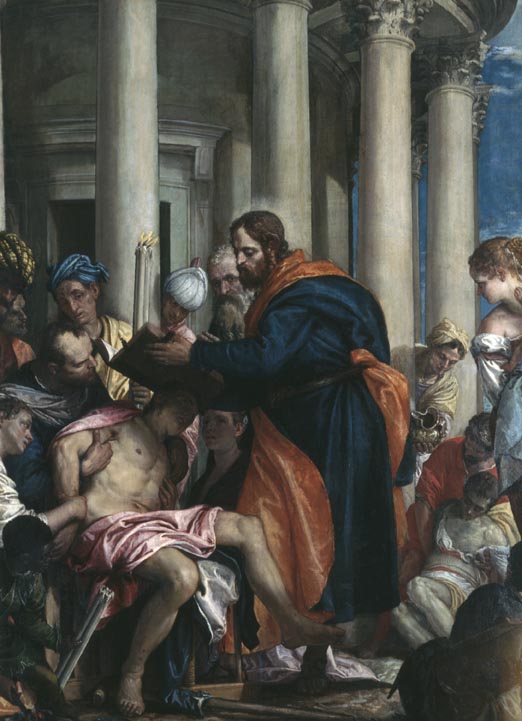* * * *

Barnabas curing the sick by Paolo Veronese, Musée des Beaux-Arts de Rouen.
* * * *
Wednesday, June 11, was the Feast Day for Saint Barnabas:
The apostle and missionary was among Christ’s earliest followers and was responsible for welcoming St. Paul into the Church. Though not one of the 12 apostles . . . he is traditionally regarded as one of the 72 disciples of Christ and [the] most respected man in the first century Church after the Apostles themselves.
See ST. BARNABAS, APOSTLE :: Catholic News Agency (CNA). The first mention of Barnabas came in Acts 4, beginning at verse 36: “Joseph, a Levite, born in Cyprus, whom the apostles called Barnabas (son of encouragement), sold a field he owned, brought the money, and turned it over to the apostles.” The site Barnabas the Apostle – Justus added that even after Paul had his Damascus Road experience, “most of the Christians [in Jersusalem] wanted nothing to do with him. They had known him as a persecutor and an enemy of the Church. But Barnabas was willing to give him a second chance.” (Which is pretty much what Jesus is all about. . .)
The “Justus” site above added this, about those “second chances;”
Later, Paul and Barnabas went on a missionary journey together, taking Mark with them. Part way, Mark turned back and went home. When Paul and Barnabas were about to set out on another such journey, Barnabas proposed to take Mark along, and Paul was against it, saying that Mark had shown himself undependable. Barnabas wanted to give Mark a second chance [again] and so he and Mark went off on one journey, while Paul took Silas and went on another. Apparently Mark responded well to the trust given him by the “son of encouragement,” since we find that Paul later speaks of him as a valuable assistant (2 Tim 4:11; see also Col 4:10 and Phil 24) .
So we might just call Barnabas “the Apostle of Second Chances.”
The Collect for his Feast Day asks God to teach us also to “follow the example of your faithful servant Barnabas, who, seeking not his own renown but the well-being of your Church, gave generously of his life and substance for the relief of the poor and the spread of the Gospel.”
The Gospel for the Day is Matthew 10:7-16, which ends with Jesus saying to His disciples, “I am sending you out like sheep into the midst of wolves; so be wise as serpents and innocent as doves.” And since “serpent” is just another name – or metaphor – for Satan, what Jesus seemed to say was that a good Christian needs to be “wise as the Devil,” or perhaps “wise as hell.”
But that’s just common sense. If you’re to resist something – like “the wiles of the world” – you definitely need to know what you’re trying to resist. If not, you’re much weaker, to the extent you don’t “know your enemy.” So even if you’re a Fundamentalist Christian and think those “exotic Eastern meditations” were simply tools of the devil – those exotic Eastern practices that were all the rage back in the 1970s – you still need to know those exotic disciplines, if you plan to fight them. Which is of course another very good reason to study the Bible.
* * * *

The ” Archangel Michael slaying Satan. . .”
* * * *
The upper image is courtesy of the Wikipedia article.
See also What is the Damascus road experience – Wiki Answers.
For the full readings for this Feast Day, see The Lectionary Page.
The Wikipedia article added this about Barnabas: “Tertullian [one of the early Church Fathers] named him as the author of the Epistle to the Hebrews, but this and other attributions are conjecture.” Tertullian in turn was famous for saying words to the effect that he believed in the resurrection “because it is absurd.” See Credo quia absurdum – Wikipedia, the free encyclopedia, referring to “a Latin phrase that means ‘I believe because it is absurd.’ It is a paraphrase of a statement in Tertullian‘s work De Carne Christi, ‘prorsus credibile est, quia ineptum est,’ which can be translated: ‘it is by all means to be believed, because it is absurd…’ The Catholic Tradition, from the outset, rejected the so-called ‘fideism,’ which is the desire to believe against reason. Credo quia absurdum (I believe because it is absurd) is not a formula that interprets the Catholic faith.'”
* * * *
The lower image is courtesy of the Wikipedia article on “Chaos,” included in the article Serpent (Bible) – Wikipedia, the free encyclopedia, which noted: “The symbol of a serpent or snake played important roles in religious and cultural life of ancient Egypt, Canaan, Mesopotamia and Greece. The serpent was a symbol of evil power and chaos from the underworld as well as a symbol of fertility, life and healing.” (Fertility?) The image caption in Wikipedia reads: “Depiction of the Christianized Chaoskampf: statue of Archangel Michael slaying Satan, represented as a dragon. Quis ut Deus? is inscribed on his shield.”
“The motif of Chaoskampf (German for “struggle against chaos”) is ubiquitous in myth and legend, depicting a battle of a culture hero deity with a chaos monster, often in the shape of a serpent or dragon.” Quis ut Deus is translated as “who is like God,” a literal translation of the name “Michael.”
* * * *